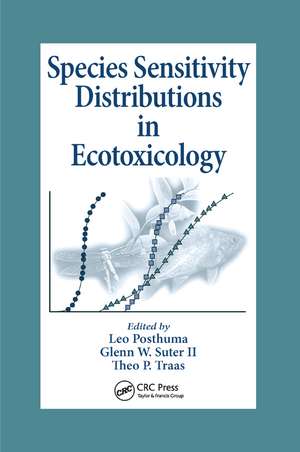Species Sensitivity Distributions in Ecotoxicology
Editat de Leo Posthuma, Glenn W. Suter II, Theo P. Traasen Limba Engleză Paperback – 7 oct 2019
Beginning with an introduction to SSDs, the chapter authors review the issues surrounding SSDs, synthesizing the positions of advocates and critics with their own analysis of each issue. Finally, they discuss the prospects for future development, paving the way for improved future uses. In sum, this book defines the field of SSD modeling and application. It reveals a lively field, with SSD-applications extending beyond legally adopted quality criteria to other applications such as Life-Cycle Analysis.
For anyone developing or revising environmental criteria or standards, this book explores the pros and cons of using the SSD approach. For anyone who needs to apply and interpret SSD-based criteria or standards, the book explains the basis for the numbers, thereby making it possible to correctly apply and defend them. For anyone performing ecological risk assessments, the book covers when and how to use SSDs including alternative assumptions, data treatments, computational methods, and available resources. Species Sensitivity Distributions in Ecotoxicology provides you with a clear picture of these standard models for estimating ecological risks from laboratory toxicity data.
| Toate formatele și edițiile | Preț | Express |
|---|---|---|
| Paperback (1) | 503.60 lei 43-57 zile | |
| CRC Press – 7 oct 2019 | 503.60 lei 43-57 zile | |
| Hardback (1) | 1782.40 lei 43-57 zile | |
| CRC Press – 20 dec 2001 | 1782.40 lei 43-57 zile |
Preț: 503.60 lei
Preț vechi: 592.47 lei
-15% Nou
Puncte Express: 755
Preț estimativ în valută:
96.38€ • 100.11$ • 80.06£
96.38€ • 100.11$ • 80.06£
Carte tipărită la comandă
Livrare economică 03-17 februarie 25
Preluare comenzi: 021 569.72.76
Specificații
ISBN-13: 9780367396480
ISBN-10: 0367396483
Pagini: 616
Dimensiuni: 156 x 234 x 31 mm
Greutate: 1.14 kg
Ediția:1
Editura: CRC Press
Colecția CRC Press
ISBN-10: 0367396483
Pagini: 616
Dimensiuni: 156 x 234 x 31 mm
Greutate: 1.14 kg
Ediția:1
Editura: CRC Press
Colecția CRC Press
Public țintă
Academic and Professional Practice & DevelopmentCuprins
General Introduction to Species Sensitivity Distributions. North American history of Species Sensitivity Distributions. European history of Species Sensitivity Distributions. Theory of Ecological Risk Assessment Based on Species Sensitivity Distributions. Normal Species Sensitivity Distributions and Probabilistic Ecological Risk Assessment. Extrapolation Factors for Tiny Toxicity Data Sets from Species Sensitivity Distributions with Known Standard Deviation. Species Sensitivity Distributions in Ecological Risk Assessment: Distributional Assumptions, Alternate Bootstrap Techniques, and Estimation of Adequate Number of Species. The Value of the Species Sensitivity Distribution Concept for Predicting Field Effects: (Non-)Confirmation of the Concept Using Semi-Field Experiments. Effects Assessment of Fabric Softeners: the DHTDMAC-Case. Use of Species Sensitivity Distributions in the Derivation of Water Quality Criteria for Aquatic life by the U.S. Environmental Protection Agency. Environmental Risk Limits in the Netherlands. A Rank-Based Approach to Deriving Canadian Soil and Sediment Quality Guidelines. Ecotoxicological Soil Quality Criteria in Denmark. The Potentially Affected Fraction as a Measure of Ecological Risk. Methodology for Aquatic Ecological Risk Assessment. Toxicity-Based Assessment of Water Quality. Mapping Risks of Heavy Metals to Birds and Mammals Using Species Sensitivity Distributions. Ecotoxicological Impacts in Life Cycle Assessment. Issues and Practices in the Derivation and Use of Species Sensitivity Distributions. Conceptual and Technical Outlook on Species Sensitivity Distributions. Appendices. References. Glossary. Acronyms. Subject Index.
Notă biografică
Leo Posthuma, Glenn W. Suter II, Theo P. Traas
Descriere
This book provides a critical review of the conceptual basis, strengths and weaknesses of using Species Sensitivity Distributions (SSDs) to model the effects of contaminants on ecosystems. For anyone developing or revising environmental criteria or standards, this book explores the pros and cons of using the SSD approach. For those applying and interpreting SSD-based criteria or standards, the book explains the basis for the numbers, thereby making it possible to correctly apply and defend them. For those performing ecological risk assessments, the book covers when and how to use SSDs including alternative assumptions, data treatments, computational methods, and available resources.
